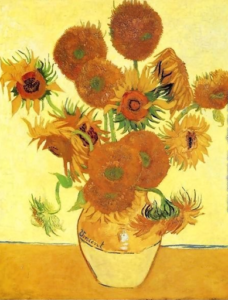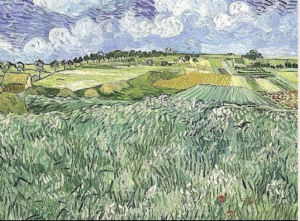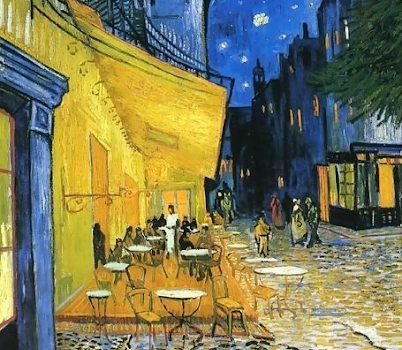
The Dutch Painter Vincent Van Gogh (1853-1890) was the founder of the Impressionist Movement. He used colors unusually for his time. Art lovers and scholars tell you that if you know more about the use of colors in Vincent van Gogh’s artwork, you get a glimpse of his mental world.
Van Gogh didn’t use the real natural colors of his objects but used colors that could affect the viewers’ emotions when looking at the depicted objects. He also applied the paint onto the canvas in unique ways. In this article, we’ll look at Van Gogh’s views about color, what colors he used, and how he applied them in his paintings.
Van Gogh’s adventurous use of color
The brilliant Vincent Van Gogh artwork, where he experimented adventurously with color, changed the visual art scene dramatically. Van Gogh deliberately used colors to capture mood and emotion. However, realistically, color is not used in Van Gogh’s drawings and paintings.
As you learn about the paintings of Van Gogh, you discover that his technique of applying colors to the canvas was also unheard of. Van Gogh’s artworks were painted rapidly, and he used the paint straight from the tube in thick, graphic brush strokes. It is said that in his last 70 days, he averaged one painting a day.
At the beginning of his art career, he usually used dark colors such as olive green, raw sienna (a yellowish-brown color), and raw umber (a dark brown color). Then later, he added bright colors such as yellow, orange-red, blue, and green.
Colors used by Vincent van Gogh
You’ll find colors such as yellow ocher, chrome yellow, cadmium yellow, chrome orange, vermilion, Prussian blue, ultramarine (a deep blue color), lead white, zinc white, emerald green, red lake, red ocher, raw sienna, and black in paintings of Van Gogh. The mood conveyed in every artwork of Vincent van Gogh is determined by the colors he uses.
Sometimes, he used complementary colors to brighten and create contrast in his famous Van Gogh drawings. However, he used one color other times, as in his “Sunflowers,” which he painted in 1888. In “Sunflowers,” he limited his palette to yellowish colors.

Interestingly, a popular theory behind Van Gogh’s color choices shifts to the lighter, yellowish colors is that he might have suffered from xanthopsia, or “yellow vision.” It is a color vision deficiency with a predominance of yellow in vision.
Van Gogh and the color theory
Although Vincent van Gogh’s artworks were initially painted with dark colors like most other Dutch painters of the time, he was always curious about colors and read many books on color theory. He was fascinated with complementary colors and discovered that yellow and purple, blue and orange, and red and green intensified each other.
After he had moved to Paris, he experimented a lot with colors, and over time, light colors replaced the dark colors in his paintings. An example of his use of complementary colors can be found in his “Self-portrait” (1889). His hair, beard, and mustache are orange, while the color of his clothes is the complementary color blue.
Van Gogh’s color symbolism
Vincent van Gogh also symbolically used color. He stated that yellow is a wonderful color – it stands for the sun. Therefore he used yellow in his famous painting “Sunflowers” and painted the flowers with almost no shadows or complementary colors. The yellow emphasizes the effect of the sun and conveys a message of life, energy, happiness and hope.
But when Van Gogh was in a “dark mood” and depressed, he used dark colors. In his painting “Shoes,” he used many brown and khaki colors. Brown is the color of earth and wood and symbolizes virtue. With the brown shoes, Van Gogh wanted to show the viewer the shoe owner’s hard life and humility. In the painting “The Night Café,” Van Gogh depicted horrible human emotions using red and its complementary color, green.
Vincent van Gogh – Japanese influence
Vincent van Gogh was influenced by prints from Japan and used the Japanese custom of painting dark outlines around objects. He then filled the outlines with areas of thick color. Apart from his preference for yellow, blue is another color that Vincent Van Gogh used predominantly in many of his paintings. He used different shades of blue and always complimented them with contrasting colors. The effect is that the blue stands out. Van Gogh associated blue with stability and depth, and it has a calming effect on your mind.
Examples of Van Gogh’s “blue” paintings are “Peasant Woman binding Sheaves,” “Plain near Auvers,” “Seascape at Saintes-Maries,” and “Starry Night.”

Vincent Van Gogh – Plain Near Auvers
Interesting color information about Van Gogh’s drawings and paintings
For interesting sake, let’s look at more detail regarding some of the most important colors used by Van Gogh.
- Naples yellow was used by Van Gogh in his first palette in The Hague and later in some of his paintings in Antwerp and Paris. Zinc yellow and chrome yellow were often combined. But chrome yellow and orange was by far the most common type of yellow used by Van Gogh.
- The brown paint he used faded on exposure to strong light and developed a cold, gray tone. He, therefore, used it in mixtures with blues to get a kind of black color.
- Van Gogh was also attracted to the translucent red lake pigments because of their intensity and color saturation. (A lake is produced through precipitation of soluble dyes with metallic salt). Cochineal lake (Carmine) was the most common lake used by Van Gogh.
- Van Gogh discovered the potential of cobalt blue, but it was very expensive, so he used Prussian blue for blue background areas.
- Van Gogh used viridian and emerald green combined but never used chrome green.
Conclusion
Because of his unique way of color-use, images of Van Gogh paintings are complicated to create and duplicate the exact colors used by Van Gogh. But through the artwork of Vincent Van Gogh, you can learn a lot about his philosophies and his mental state by looking for the symbolism in his way of using color. This is because Vincent van Gogh’s images and colors almost always have a symbolic value.
Read more interesting articles at goodthing2








